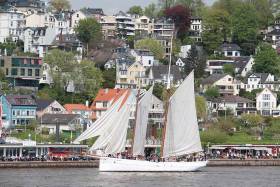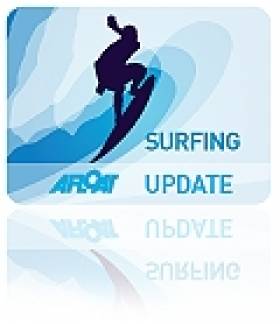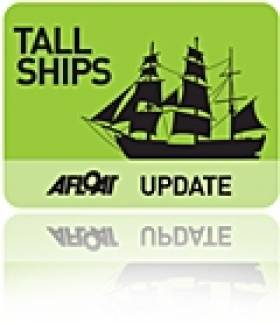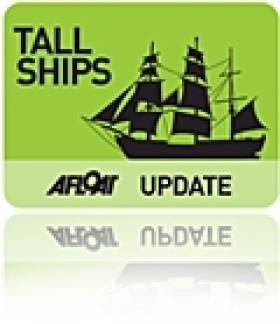Displaying items by tag: Germany
A newly restored tall ship dating from the 19th century has been sunk after a collision with a container ship near Hamburg in Germany.
The Guardian reports that six adults and two children were injured among the 43 passengers rescued from the schooner Elbe No 5 after a failed tack put it on a collision course in the shipping lane with the Cyprus-flagged Astrosprinter on the River Elbe on Saturday (8 June).
The tall ship, which was originally built in 1883, had been restored in a €1.5 million project over the last nine months and had only resumed taking passengers on trips around Hamburg’s harbour at the end of May.
But it has now been lost as it sank while rescuers were towing it to shore.
“If we hadn’t been in the vicinity there could have been fatalities,” said one fire service official of the calamity.
The Guardian has more on the story HERE.
#Rowing: Ireland’s Margaret Cremen and Aoife Casey finished second in their semi-final and will compete in the A Final of the double sculls at the European Junior Rowing Championships in Krefeld in Germany. The Skibbereen/Lee combination were just .31 of a second off winners Denmark in their race and had the second-fastest time overall as they head into the A Final.
Three other crews – the men’s pair and quadruple and the women’s pair – finished outside the A Final places.
European Junior Championships, Krefeld, Germany (Selected Results; Irish interest)
Men
Pair – Semi-Final B: 6 Ireland (A Johnston, R Corrigan) 7:17.95.
Sculling, Quadruple – Semi-Final B: 5 Ireland (J Quinlan, J Keating, M Dundon, B O’Flynn) 6:20.31.
Women
Pair – Semi-Final A: 4 Ireland (G McGill, E O’Reilly) 7:51.31.
Sculling, Double – Semi-Final B: 2 Ireland (A Casey, M Cremen) 7:26.83.
German Media Treated To Loop Head Lighthouse Tour
#Lighthouse - German journalists were recently taken on a tour of Loop Head Lighthouse to give our European neighbours a taste of Ireland's maritime heritage.
The group - including writers from the likes of respected news magazine Der Spiegel - visited the 19th-century landmark in Co Clare which opened to visitors at weekends earlier this month, and will be open seven days a week from the June Bank Holiday over the summer season for the third year running.
Before then, it will welcome visitors during the National Famine Commemoration programme from 3-12 May.
As previously reported on Afloat.ie, the lighthouse at the mouth of the Shannon Estuary has proven a major tourism draw, with its 11-week trial opening in 2011 estimated to be worth €400,000 to the local economy.
Olympic Canoe Slalom Qualifying Spots Snapped Up in Lucan
#CANOEING - The Irish Times reports that Eoin Rheinisch and Ciarán Heurteau have secured their canoe slalom qualification spots for London 2012 after last weekend's selection races in Lucan.
Three places were up for grabs in the men's K1, with the third yet to be confirmed after fourth-placed Patrick Hynes contested a touch on a gate by third-place finisher Sam Curtis.
Canoeing Ireland's recently appointed general manager Karl Dunne said the objection is currently being considered.Meanwhile, in the women's K1, the qualifying spots went go Hannah Craig, Helen Barnes and Aisling Conlon.
The qualifiers will be part of the European Championships in Augusburg, Germany from 10-13 May, where Olympic spots are available for boats from two countries not already qualified.
Top German Surfer Tries Ireland's Waves for Size
#SURFING - One of Germany's top surfers was in Ireland last week to sample some of Ireland's biggest waves, InsideIreland.ie reports.
Sebastian Steudtner was in Sligo to films a series of online views for Tourism Ireland in Frankfurt to pique the interest of German surfers and holidaymakers.
As well as mountain biking at Knocknarea and Union Woods, Steudtner took on the monster swells at Mullaghmore Head - made popular among the world's big wave surfers by the Tow-In Surf Session that's now in its second year.
The 'teaser' videos for a larger TV and online project will be premiered next week at the Berlin International Film Festival before hitting the web later in spring.
Kristina Gauges of Tourism Ireland said: "This is a fantastic opportunity to showcase the world-class surfing and adventure product available in this part of Ireland to a niche audience in Germany."
InsideIreland.com has more on the story HERE.
Five Represent Ireland at Canoe Slalom World Cup
Eoin Rheinisch joins four others representing Ireland at the Canoe Slalom World Cup today.
Ciarán Heurteau, Patrick Hynes, Hannah Craig and Aisling Conlan round out the squad competing in Leipzig, Germany.
Rheinisch told The Irish Times that he was "shattered" after a week of hard training in Bratislava, aiming for the World Championships and Olympic qualification there in September.
"But they are the kind of sessions I need to be getting intermittently,” he said.
US Cutter Eagle On Its Way to Waterford
The US Coast Guard cutter Tall Ship Eagle has set sail on its 75th anniversary voyage to Europe - with Ireland being its first port of call.
Captain Eric C Jones, who pilots the US Coast Guard's training vessel and goodwill ambassador, said the trip was a special one for him and the more than 140 cadets on board, as it will be revisiting the shipyard in Hanover, Germany where it was built in 1936.
Other stops include London, Reykjavik, and Halifax in Nova Scotia before a final stop in New York on 5 August, according to The Day.
Dignitaries and residents from the Eagle's home port of New London, Connecticut will be heading to Waterford - host of the Tall Ships Races this summer - to welcome its arrival in 27 May.
Watch some video of the Eagle in action:
Hamburg Gets Ready to Host World's Biggest Ports Festival
Billed as the world's greatest Port Festival, five of the world's largest and most beautiful tall ships – and at least one, the Mir, is also entered for the Tall Ships race in Waterford in June – have announced their presence at Hamburg next month.
Also coming to Hamburg is the Dar Mlodziezy, the Kruzenshtern, the Mir, the Sedov and the Sea Cloud. Each of these classic sailing ships, at home on the oceans of the world, is more than 100 metres in length, and captures the romance of maritime life.
The HAFENGEBURTSTAG HAMBURG has a thing or two to show off about given its large fleet of boats and Tall Ships that are gathering this year for the 822nd time. It's an opportunity to for Irish port festivals aiming to exploit the marine leisure resources around the Irish coastline.
The Sea Cloud, built in Kiel in 1931, and the largest private yacht in the world at the time, will be present at HAFENGEBURTSTAG HAMBURG for the first time, back in Hamburg for the first time in 33 years.
In Hamburg, there will be tall ships and cruise vessels, naval ships and emergency service boats, heritage and museum ships, sailing and motor yachts, dragon boats, and even a Roman galley. Altogether more than 300 vessels from the seven seas will be taking part, on display in their element before the fantastic backdrop of Hamburg's Landing Stages (Landungsbrücken) from 6 to 8 May at the world's greatest Port Festival.
The port is more lively than ever on the three days of HAFENGEBURTSTAG HAMBURG", says Captain Jörg Pollmann, in eager anticipation. "All those different ships and displays on the Elbe combine to form a unique celebration, which brings more than a million visitors to the Port of Hamburg every year." The guests from Germany and abroad can look forward to a superlative programme on the water, starting with the Grand Arrival Parade from 16:30 on Friday 6 May, and ending with the Grand Departure Parade at 17:30 on Sunday 8 May. There are also plenty of maritime attractions at the Oevelgönne Heritage Harbour and at the HafenCity traditional maritime harbour.
Meeting of the luxury liners
Visitors are warned that watching the six cruise ships arriving and departing on the three days of HAFENGEBURTSTAG HAMBURG may cause itchy feet and severe travelitis! The AIDAcara, AIDAblu and Mein Schiff 2 will be arriving on the Friday, the Amadea and the Fram, an expedition ship from Norway, will follow on the Saturday. And to top it all, the Queen Mary 2 will call in Hamburg on the Sunday. Costa Crociere, Europe's largest cruise ship operator, has just chosen Hamburg as the new home port for its cruise ship Costa Magica, and will join in the celebrations, sponsoring the great Costa Cruises Firework Display at 22:30 on Saturday 7 May, lighting up the night sky over the Elbe.
International navy visit and maritime adventurer from Norway
The world's greatest Port Festival traditionally brings a large naval contingent from Germany and elsewhere to Hamburg. From Germany there will be the frigate Sachsen, the fast patrol boat Hermelin and the mine hunters Homburg and Hameln. Norway, the partner country of HAFENGEBURTSTAG HAMBURG, will be represented by the frigate Otto Sverdrup, and Belgium by the mine hunters Crocus and Primula.
Norway, the partner country for this year's HAFENGEBURTSTAG HAMBURG, is also sending vessels of various designs and uses to visit Hamburg. The Arctic sailing ship Berntine will welcome visitors on board in the HafenCity Traditional Harbour. She was built at the Tromsøer shipyard in 1890 and restored several times since then. Sjøkurs is a training ship, built by the Hamburg shipyard Blohm & Voss in 1956 as the Postal Vessel Ragnvald Jarl. Today she accommodates 60 cadets on board, and travels around Norway and to other countries about ten weeks per year. The Fram, an expedition ship, will moor at the Hamburg Cruise Center in HafenCity. She is the latest addition to the Hurtigruten fleet and was christened by Norway's Crown Princess Mette Marit on 16 May 2007.
On duty for safety and security
The challenges of work on the high seas will be demonstrated by a range of modern working vessels from the fire services, fisheries protection, THW emergency services, the waterways police and the customs. The rescue cruiser John T. Essberger, owned by the German Lifeboat Institution DGzRS, will make its final appearance at HAFENGEBURTSTAG HAMBURG before decommissioning. It will then start on its final voyage to the Technical Museum of Speyer, where it will in future be moored as a museum vessel.
Dancing tug boats and heritage ships
One of the traditional highlights of the maritime programme is the unique Tug Boat Ballet at 17:00 on the Saturday, when the 5000 hp working tugboats perform their pirouettes on the Elbe.
A fleet of classic steamships will give a special birthday greeting from the Oevelgönne Heritage Harbour when they pass the Landing Stage at 16:00 on the Saturday, "full steam ahead" – not only puffing out clouds of smoke from their chimneys, but also releasing balloons from their decks.
On-board visits
Many of the vessels at HAFENGEBURTSTAG HAMBURG, including the tall ships and naval units, will hold Open Days for visitors to look around on board. Many of the launches and passenger ships also invite visitors to HAFENGEBURTSTAG HAMBURG to go on board and join in the Parades, or to tour the vessel.




































































